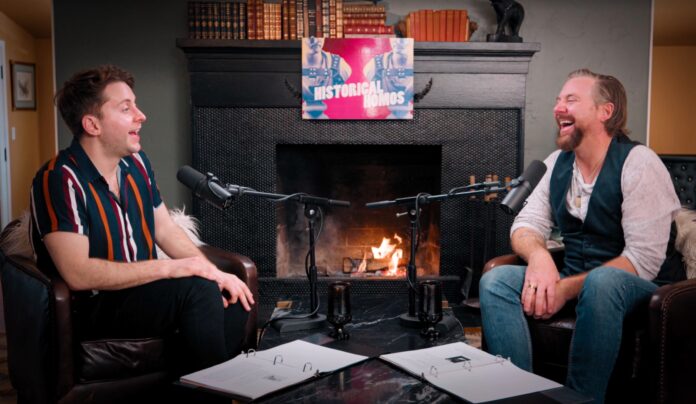“Historical Homos” is an unfiltered look at how “history is gay AF.” Podcast cohosts Bash and Donal Brophy investigate LGBT history in their informative and irreverent series. The show, which is available starting June 9 on Dekkoo in video form and in a podcast on Spotify, offers one new episode each week over four consecutive weeks.
Bash is the educated historian here, and Brophy sets him up by asking for context and interjecting questions and playful comments throughout the discussions. The duo has fun riffing off each other as they recount some of the sexier aspects of historical figures, and their cheekiness includes some explicit language.
The first episode, “Toxic Boyfriends of Greek Mythology,” examines the relationship between older and younger men in ancient Athens. Bash and Donal’s conversational approach — they are seen chatting in front of microphones — is illustrated with images, Greek statues, and amusing captions that enhance their personal anecdotes and sassy asides, as when Donal admits he had a “Call Me by Your Name”-like relationship as a teenager in Italy, and the episode cuts to a film clip.
Taking his cue from the myth of Zeus and Ganymede, Bash acknowledges that we often look at Greek sexuality through a modern lens, and that these historical same-sex relationships were not considered inappropriate at the time — even though they involved older men and teenagers. Not only was life expectancy around 30, but young women were also prone to being involved with older men. Moreover, there was a mentoring taking place that helped normalize these relationships.
These insights, along with a discussion of how soldiers had boyfriends — it made them fight harder to protect someone they cared about — illuminate and demystify some of the long-held assumptions made about queer Greek society.
The second episode unpacks the gender fluid “Le Chevalier d’Éon,” an 18th century French spy/soldier who lived as a woman at a time when women were still suffering indignities in society despite some gains in power. Dressed in female garb at a drag ball, the Chevalier captured the interest of King Louis XVI. What is more, d’Éon was admired by King Louis for his many diplomatic and militaristic accomplishments. But while he was living in the UK, The Chevalier dressed and lived as a woman; there were even bets placed on d’Éon’s gender in pubs. Bash and Brophy enthusiastically recount d’Éon’s life, and suggest the Chevalier may have been asexual, but they do tend to get a bit silly with their asides, which include putting breasts on George Washington.
Episode three asks the burning question: “Shakespeare vs. Christopher Marlowe: Who’s Gayer?” The hosts question if there is “straightwashing” going on here, with both writers’ sexuality being questioned. Shakespeare and Marlowe each penned poetry for the same twink, Bash claims. And a discussion of sodomy provides context regarding the sexuality of the 1500s, when there was no “gay identity.” These so-called “theatre queens” frequently wrote about same-sex love. Marlowe’s “Edward II,” a tragedy about power, depicted the King’s romance with Piers Gaveston. In contrast, Shakespeare’s sonnets to a Fair Youth — Bash recites Sonnet 20 — suggests a woman is actually a man. Was Marlowe gay and Shakespeare bisexual? Perhaps. But the cases made in “Historical Homos” are inconclusive. And Brophy’s attempt to compare Marlowe’s work to Kurt Cobain’s with “pop hooks” falls flat. This may be the series’ weakest episode.
The final show, “Virginia & Vita Invent the Lesbian Love Letter,” also analyzes two British writers. Bash describes how Virginia Woolf and Vita Sackville-West became lovers in the early twentieth century, when Virginia was part of the Bloomsbury Group which included the gay writers E. M. Forster and Lytton Strachey, as well as gay painter Duncan Grant, among others. Both women were married to men, though it is suggested that the aristocratic Vita and her husband, Harold Nicolson, had an open relationship as each had same-sex affairs. As the women got to know each other, and briefly traveled together, they mostly corresponded, writing passionate letters, some of which Bash and Brophy read with gusto and reverence.
Vita helped Virginia feel comfortable with her sexuality, and Vita is credited as the inspiration for Woolf’s novel, “Orlando,” about a man who travels through time and wakes up as a woman; the story was meant to “novelize” Sackville-West’s bisexuality. This episode excels because it gives a strong sense of the history and culture at the time, as the rules about gender and sexuality were being challenged although WWII was on the horizon.
“Historical Homos” will certainly whet its audience’s appetites to read and learn more about the subjects discussed. And Bash and Brophy’s candor is amusing even if it not suitable for school. It is disappointing that the four episodes focus exclusively on European figures, but hopefully the series will continue and investigate what is queer about American history. In the meantime, folks can appreciate this queer take on the past.
